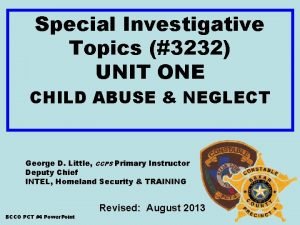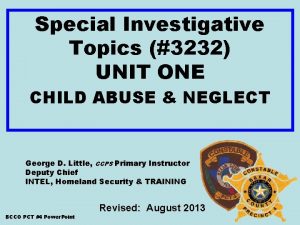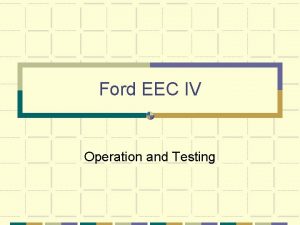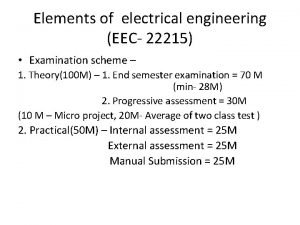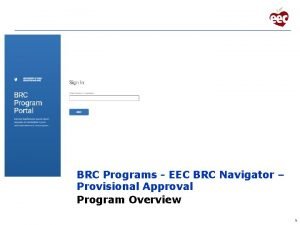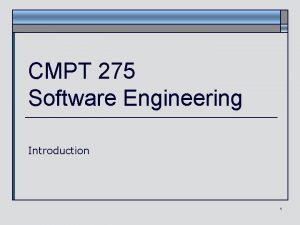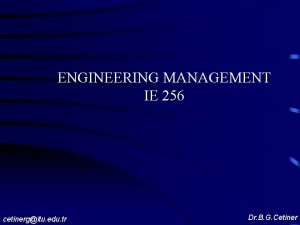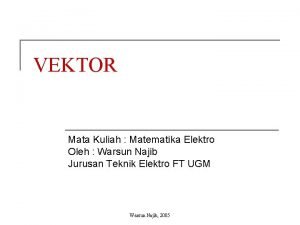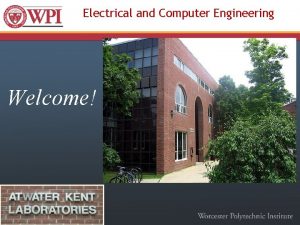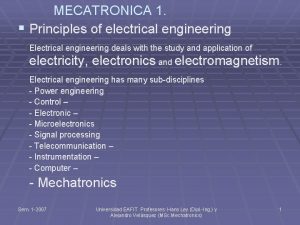EEC 693793 Special Topics in Electrical Engineering Secure






































- Slides: 38

EEC 693/793 Special Topics in Electrical Engineering Secure and Dependable Computing Lecture 3 Wenbing Zhao Department of Electrical and Computer Engineering Cleveland State University wenbing@ieee. org Spring 2007 EEC 693: Secure & Dependable Computing

2 Outline • • Types of threats Meaning of computer security Vulnerabilities in computer systems Threats in computer networks Spring 2007 EEC 693: Secure & Dependable Computing 2

3 Type of Threats • An interception means that some unauthorized party has gained access to an asset • In an interruption, an asset of the system becomes lost, unavailable, or unusable • If an unauthorized party not only accesses but tampers with an asset, the threat is a modification • An unauthorized party might create a fabrication of counterfeit objects on a computing system Spring 2007 EEC 693: Secure & Dependable Computing 3

4 Type of Threats Spring 2007 EEC 693: Secure & Dependable Computing 4

5 Interception • An interception means that some unauthorized party has gained access to an asset – Example: illicit copying of program or data files, or wiretapping to obtain data in a network – Unlike a loss, which may be discovered fairly quickly, a silent interceptor may leave no traces by which the interception can be readily detected Spring 2007 EEC 693: Secure & Dependable Computing 5

6 Interruption • In an interruption, an asset of the system becomes lost, unavailable, or unusable – Example: malicious destruction of a hardware device – Example: erasure of a program or data file – Example: (distributed) denial of service attacks Spring 2007 EEC 693: Secure & Dependable Computing 6

7 Modification • If an unauthorized party not only accesses but tampers with an asset, the threat is a modification – Example: someone might change the values in a database, alter a program so that it performs an additional computation – Example: modify message being transmitted over the network – Some cases of modification can be detected with simple measures, but other, more subtle, changes may be almost impossible to detect Spring 2007 EEC 693: Secure & Dependable Computing 7

8 Fabrication • An unauthorized party might create a fabrication of counterfeit objects on a computing system – Example: the intruder may insert spurious transactions to a network communication system or add records to an existing database – Sometimes these additions can be detected as forgeries, but if skillfully done, they are virtually indistinguishable from the real thing Spring 2007 EEC 693: Secure & Dependable Computing 8

9 Threats: Methods, Opportunity, and Motive • A malicious attacker must have three things: – Method: the skills, knowledge, tools, and other things with which to launch an attack – Opportunity: the time and access to accomplish the attack – Motive: a reason to want to perform this attack against this system Spring 2007 EEC 693: Secure & Dependable Computing 9

The Meaning of Computer Security • The purpose of computer security is to devise ways to prevent the weaknesses from being exploited • What we mean when we say that a system is secure: – Confidentiality: computer-related assets are accessed only by authorized parties. Confidentiality is sometimes called secrecy or privacy – Integrity: assets can be modified only by authorized parties or only in authorized ways – Availability: assets are accessible to authorized parties at appropriate times Spring 2007 EEC 693: Secure & Dependable Computing 10 10

11 Relationship of Security Goals • A secure system must meet all three requirements • The challenge is how to find the right balance among the goals, which often conflict – For example, it is easy to preserve a particular object's confidentiality in a secure system simply by preventing everyone from reading that object – However, this system is not secure, because it does not meet the requirement of availability for proper access – => There must be a balance between confidentiality and availability Spring 2007 EEC 693: Secure & Dependable Computing 11

12 Relationship of Security Goals Spring 2007 EEC 693: Secure & Dependable Computing 12

13 Confidentiality • It is not trivial to ensure confidentiality. For example, – Who determines which people or systems are authorized to access the current system? – By "accessing" data, do we mean that an authorized party can access a single bit? pieces of data out of context? – Can someone who is authorized disclose those data to other parties? • Confidentiality is the security property we understand best because its meaning is narrower than the other two • We also understand confidentiality well because we can relate computing examples to those of preserving confidentiality in the real world Spring 2007 EEC 693: Secure & Dependable Computing 13

14 Integrity • It is much harder to ensure integrity. One reason is that integrity means different things in different context • For example, if we say that we have preserved the integrity of an item, we may mean that the item is: – – – – – precise accurate unmodified only in acceptable ways modified only by authorized people modified only by authorized processes consistent internally consistent meaningful and usable Spring 2007 EEC 693: Secure & Dependable Computing 14

15 Integrity • Aspects of integrity: computerized data are the same as those in source documents; they have not been exposed to accidental or malicious alteration or destruction • Aspects of integrity: authorized actions, separation and protection of resources, and error detection and correction • Integrity can be enforced in much the same way as can confidentiality: by rigorous control of who or what can access which resources in what ways Spring 2007 EEC 693: Secure & Dependable Computing 15

16 Availability • Availability applies both to data and to services (i. e. , to information and to information processing), and it is similarly complex • We say a data item, service, or system is available if – There is a timely response to our request – There is a fair allocation of resources, so that some requesters are not favored over others – The service or system involved are fault tolerant - hardware or software faults lead to graceful cessation of service or to workarounds rather than to crashes and abrupt loss of information – The service or system can be used easily and in the way it was intended to be used – …. Spring 2007 EEC 693: Secure & Dependable Computing 16

17 Availability • The security community is just beginning to understand what availability implies and how to ensure it • A small, centralized control of access is fundamental to preserving confidentiality and integrity, but it is not clear that a single access control point can enforce availability • Much of computer security's past success has focused on confidentiality and integrity; full implementation of availability is security's next great challenge Spring 2007 EEC 693: Secure & Dependable Computing 17

18 Vulnerabilities • When we prepare to specify, design, code, or test a secure system, we try to imagine the vulnerabilities that would prevent us from reaching one or more of our three security goals • The three assets (hardware, software and data) and the connections among them are all potential security weak points Spring 2007 EEC 693: Secure & Dependable Computing 18

19 Vulnerabilities Spring 2007 EEC 693: Secure & Dependable Computing 19

20 Software Vulnerabilities • Software is surprisingly easy to delete and to copy • Software is vulnerable to modifications that either cause it to fail or cause it to perform an unintended task Spring 2007 EEC 693: Secure & Dependable Computing 20

21 Software Vulnerabilities • Logic bomb: a program that has been maliciously modified to fail when certain conditions are met or when a certain date or time is reached • Trojan horse: a program that overtly does one thing while covertly doing another • Virus: a specific type of Trojan horse that can be used to spread its "infection" from one computer to another • Trapdoor: a program that has a secret entry point • Information leaks in a program: code that makes information accessible to unauthorized people or programs Spring 2007 EEC 693: Secure & Dependable Computing 21

22 Data Vulnerabilities • Data items have greater public value than hardware and software, because more people know how to use or interpret data • By themselves, out of context, pieces of data have essentially no intrinsic value • On the other hand, data items in context do relate to cost, perhaps measurable by the cost to reconstruct or redevelop damaged or lost data Spring 2007 EEC 693: Secure & Dependable Computing 22

23 Data Vulnerabilities • Confidential data leaked to a competitor may narrow a competitive edge • Data incorrectly modified can cost human lives • Inadequate security may lead to financial liability if certain personal data are made public Spring 2007 EEC 693: Secure & Dependable Computing 23

24 Data Vulnerabilities • The value of data over time is far less predictable or consistent • Initially, data may be valued highly. However, some data items are of interest for only a short period of time, after which their value declines precipitously Spring 2007 EEC 693: Secure & Dependable Computing 24

25 Principle of Adequate Protection • Principle of Adequate Protection: – Computer items must be protected only until they lose their value – They must be protected to a degree consistent with their value Spring 2007 EEC 693: Secure & Dependable Computing 25

26 Security of Data Integrity prevents unauthorized modification Confidentiality prevents unauthorized disclosure of a data item Spring 2007 EEC 693: Secure & Dependable Computing Availability prevents denial of authorized access 26

27 Threats in Networks • Networks are specialized collections of hardware, software, and data – Each network node is itself a computing system – It experiences all normal security problems • A network must also confront communication problems that involve the interaction of system components and outside resources Spring 2007 EEC 693: Secure & Dependable Computing 27

28 Threats in Networks • The challenges to achieve network security are rooted in – A network's lack of physical proximity – Use of insecure, shared media, and – The inability of a network to identify remote users positively Spring 2007 EEC 693: Secure & Dependable Computing 28

29 What Makes a Network Vulnerable • Anonymity. An attacker can mount an attack from thousands of miles away and never come into direct contact with the system, its administrators, or users • Many points of attack—both targets and origins. An attack can come from any host to any host, so that a large network offers many points of vulnerability Spring 2007 EEC 693: Secure & Dependable Computing 29

30 What Makes a Network Vulnerable • Sharing. Because networks enable resource and workload sharing, more users have the potential to access networked systems than on single computers • Complexity of system. A network combines two or more possibly dissimilar operating systems. • Unknown network boundary. A network's expandability also implies uncertainty about the network boundary Spring 2007 EEC 693: Secure & Dependable Computing 30

What Makes a Network Vulnerable 31 Unknown network boundary Spring 2007 EEC 693: Secure & Dependable Computing 31

32 What Makes a Network Vulnerable • Unknown path in message routing. There may be many paths from one host to another. Some intermediate node might not be trustworthy Spring 2007 EEC 693: Secure & Dependable Computing 32

33 Methods of Defense • Harm occurs when a threat is realized against a vulnerability • To protect against harm, we can neutralize threat, close the vulnerability, or both • The possibility for harm to occur is called risk Spring 2007 EEC 693: Secure & Dependable Computing 33

34 Methods of Defense • We can deal with harm in several ways. We can seek to – Prevent it, by blocking the attack or closing the vulnerability – Deter it, by making the attack harder, but not impossible – Deflect it, by making another target more attractive (or this one less so) – Detect it, either as it happens or some time after the fact – Recover from its effects Spring 2007 EEC 693: Secure & Dependable Computing 34

35 Methods of Defense – Multiple Controls Spring 2007 EEC 693: Secure & Dependable Computing 35

36 Countermeasures / Controls • Encryption – Scrambling process • Software controls • Hardware controls – hardware or smart card implementations of encryption • Policies and Procedures – Example: change password periodically • Physical Controls – Example: Locks on doors, guards at entry points Spring 2007 EEC 693: Secure & Dependable Computing 36

37 Software Controls • Internal program controls: parts of the program that enforce security restrictions, such as access limitations • Operating system and network system controls: limitations enforced by the operating system or network to protect each user from all other users • Independent control programs: application programs, such as password checkers, intrusion detection utilities, or virus scanners, that protect against certain types of vulnerabilities • Development controls: quality standards under which a program is designed, coded, tested, and maintained, to prevent software faults from becoming exploitable vulnerabilities Spring 2007 EEC 693: Secure & Dependable Computing 37

38 Principle of Effectiveness • Principle of Effectiveness: Controls must be used—and used properly—to be effective. They must be efficient, easy to use, and appropriate Spring 2007 EEC 693: Secure & Dependable Computing 38
 Software engineering course syllabus
Software engineering course syllabus Eec engineering meaning
Eec engineering meaning Special investigative topics 3232 quizlet
Special investigative topics 3232 quizlet Dena schlosser
Dena schlosser Referentiel bts nrc
Referentiel bts nrc Ford eec iv
Ford eec iv Eec members
Eec members Magnetomotive force
Magnetomotive force Brc program
Brc program Beethoven eec
Beethoven eec Eec members
Eec members Eec
Eec Ccfa eec
Ccfa eec Eec diode
Eec diode Directive 86/609/eec
Directive 86/609/eec Uiuc cs 527
Uiuc cs 527 Software engineering important topics
Software engineering important topics Elements of engineering drawing
Elements of engineering drawing Engineering management topics
Engineering management topics Engineering meeting topics
Engineering meeting topics Financial engineering thesis topics
Financial engineering thesis topics Pengurangan vektor
Pengurangan vektor George washington university electrical engineering
George washington university electrical engineering Tel aviv university electrical engineering
Tel aviv university electrical engineering Northwestern university computer engineering
Northwestern university computer engineering Klipsch school of electrical and computer engineering
Klipsch school of electrical and computer engineering Electrical engineering department
Electrical engineering department Umd ece faculty
Umd ece faculty Cleat wiring system
Cleat wiring system Electrical engineering environmental issues
Electrical engineering environmental issues Cs flowchart wpi
Cs flowchart wpi Electrical engineering presentation
Electrical engineering presentation Kfupm ee faculty
Kfupm ee faculty Big data in electrical engineering
Big data in electrical engineering Chapter 11 electrical engineering
Chapter 11 electrical engineering Analogy between electric and magnetic circuits
Analogy between electric and magnetic circuits University of belgrade school of electrical engineering
University of belgrade school of electrical engineering Electrical engineering notation
Electrical engineering notation Bus electrical engineering
Bus electrical engineering


